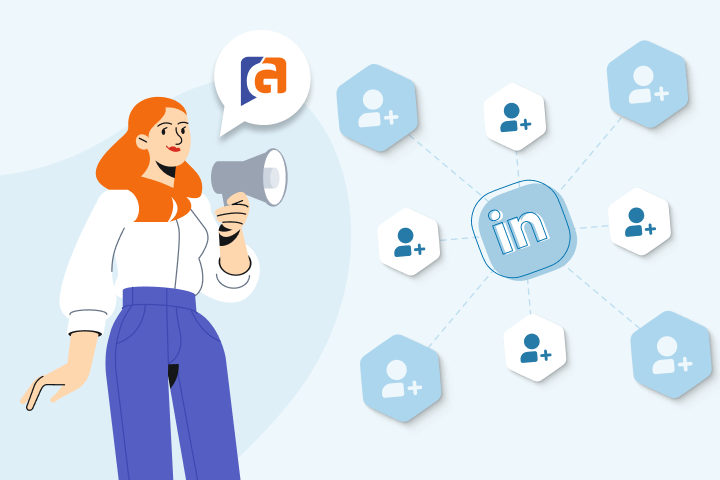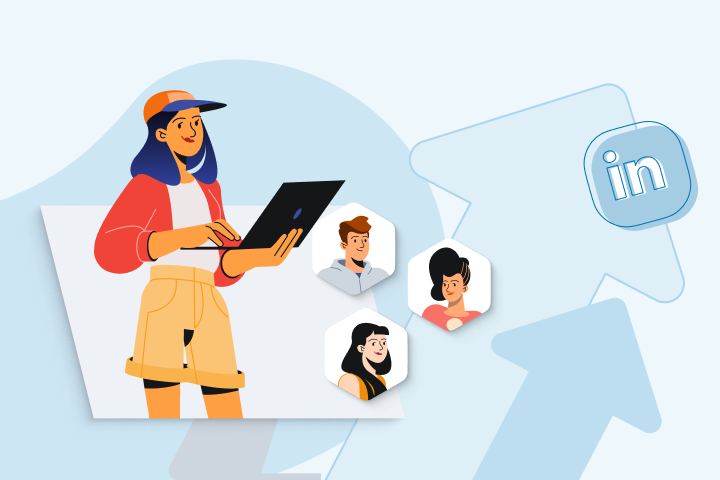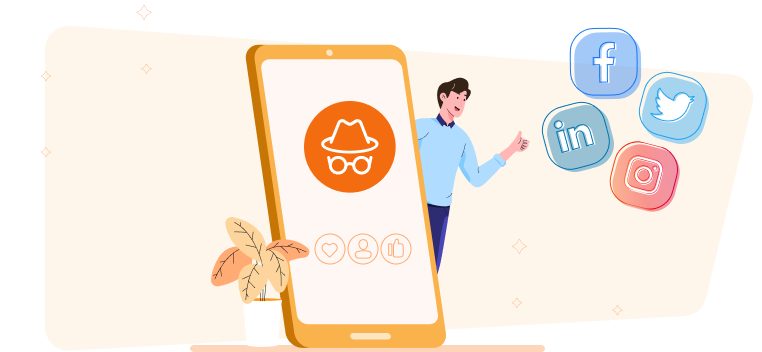Social Media for Executives: An Easy Step-by-Step Guide
Executives with strong social media followings are invaluable to brands because they can amplify any brand initiative with a single social media post. This translates to more customers, funding, partnerships, and industry authority for the brand.
However, only a fraction of executives invest in building their personal social media presence.
Many don’t fully understand the value of social media and therefore find the content creation process too time-consuming.
So, in this post, we’ll discuss the main benefits of executive social presence (which you can use when pitching the idea to internal leaders) and then lay out an executive social media strategy that makes it easy for executives to engage.
Benefits of Having Executives Active on Social Media
Below we'll discuss a few key benefits of building a stronger executive presence on social media. (You can also use each of the following points to persuade your team to invest in an executive thought leadership strategy!)
1. Increases Brand Awareness
The more followers your executives have on their personal social media accounts, the larger the megaphone the brand will have access to when promoting product launches and other company announcements.
For example, if you have five critical executives with 10,000 unique followers each on a single social media platform, you'll be able to amplify your brand's message to an additional 50,000 people.
The additional brand awareness can help you increase sales, and it's also a great way to form strategic partnerships and achieve other key company initiatives.
2. Improves Brand Trust
People tend to trust other people more than brands, so use this to your advantage.
Allowing your customers to connect a real person to your brand will likely increase their trust in your brand.
Rand Fishkin, CEO of SparkToro, is an excellent example of an individual who has built a strong social media presence to aid company growth.
For example, you'll rarely see a feature release post receive so much engagement:
Though in the comments, you can see that people truly trust Rand, and it's a key reason why they actively engage with the brand:
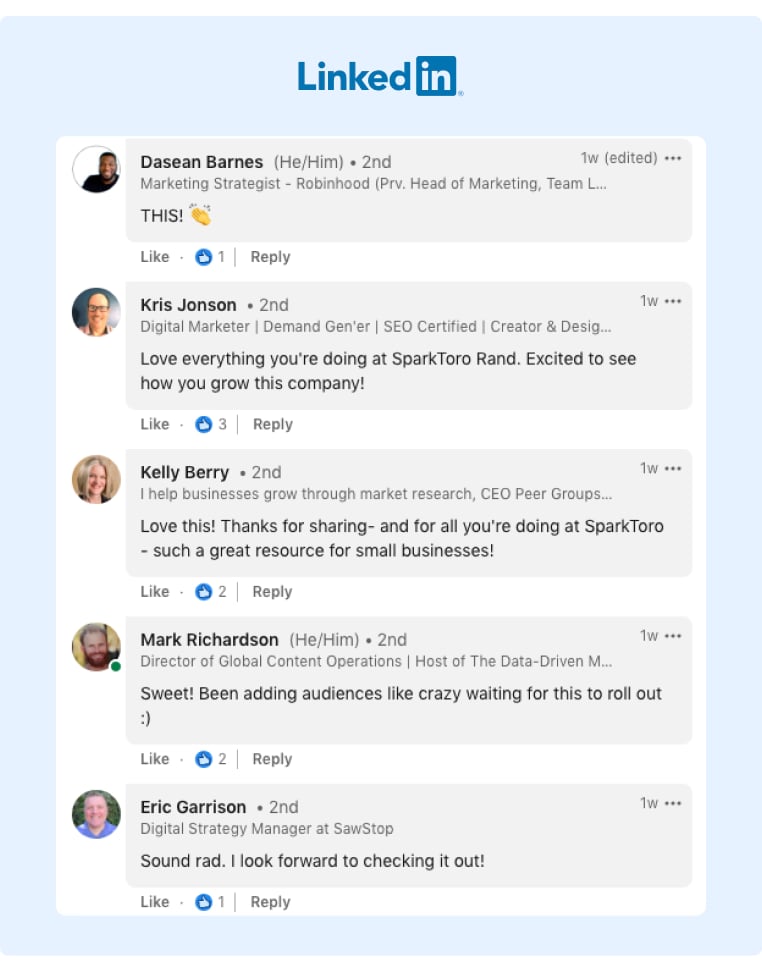
By creating a face people can associate with the brand, you'll likely see more customer loyalty and authentic engagement.
3. Creates a Culture of Employee Advocacy
When your executive leaders actively promote the brand on their personal social media accounts, your employees are more likely to follow along and post about company initiatives on their social media accounts.
For example, many team leaders at CRM company Close actively post about company updates, and as a result, many of their employees also post about company news, hiring, and culture.
Here's a great example of employee advocacy in action from an engineering leader:
Here’s another excellent example of employee advocacy from the Close team:
4. Improves Customer Communication
If executives actively engage with customers on social media, they'll stay up-to-date with exactly what customers want, which can influence product decisions, marketing messaging, and positioning.
For example, Ahrefs's CMO, Tim Soulo, came across a customer complaint on Twitter and used the feedback to improve the product.
Throughout the thread, customers mentioned what they did and didn't like about the various features, and then Soulo relayed those suggestions to the product team.
Folks, we're actually working on adding features and adjusting the design of Overview 2.0 at THIS VERY MOMENT.
— Tim Soulo 🇺🇦 (@timsoulo) December 6, 2022
So it would really help us a lot if you would share what EXACTLY you need from 1.0.
There's a very high chance that we'll add it to 2.0 😉 https://t.co/3vdNGxQD9z
When customers see an executive respond to their complaint on social media, it makes them feel heard, further strengthening their relationship with your brand. In addition, potential customers will see that your executives care about the customer experience, and that your brand works hard to accommodate requests.
5. Attracts Top Talent
Top talent actively seeks out companies that hire other top performers, so if your executives establish themselves as thought leaders, it's much easier to recruit a talented team.
For example, Alex Hormozi of Acquisition started building his own social media following over the past year and recently claimed that the most significant benefit of a strong personal brand is talent acquisition. Rather than hiring recruiting firms to try to persuade top talent, he says that the best candidates actively reach out to his brand organically.
You can also see that when his brand does post a new job, it receives excellent engagement:
Creating an Effective Social Media Strategy for Executives
While pitching the benefits of social media is a great way to earn buy-in from executives, the key to creating a sustainable executive thought leadership program is making it as easy as possible for executives to create and post content.
Most executives will probably agree that having a strong personal brand would be nice, though they might object by saying that they:
-
Don't have the time to create content several times per week.
-
Don't know what to post or write.
-
Don't know how to create an effective strategy.
So, here's a step-by-step process you can swipe to make it easy for your executives to build a powerful personal brand.
1. Plan the Strategy
Before asking executives to post content, decide on a particular content style. The more consistent the content style and tone are, the easier it is to build a loyal following, as people tend to gravitate to certain content styles and personas.
Rand Fishkin is an excellent example of a person who consistently produces the same video content format:
He has a relatable persona, and people can always expect thought-provoking marketing perspectives in the same simple video format.
Gaetano Nino DiNardi is another example of a marketing influencer who creates text-based content in a distinct style and tone. His posts are somewhat provocative and usually open with a contrarian stance that sparks thoughtful conversation in the comments.

Most people gravitate towards a specific content style or approach, so defining your executives' approach before launching a content strategy will help them build a more engaged and loyal following.
Another critical aspect to cover while planning the social media content strategy is the publishing schedule. Aim to publish at least three times per week, though the higher the frequency, the better.
If you use a tool like GaggleAMP, executives can schedule their social media posts in advance. This makes social media management easy for you, and they only have to spend time on content creation once per week.
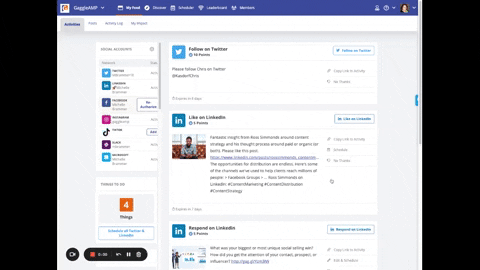
2. Aid the Content Ideation Process
Sitting in front of a blank screen and brainstorming social media content ideas from scratch is intimidating. In fact, it's usually enough to cause executives to give up on social media before they ever get started.
To eliminate this pain point, give executives specific topic prompts to help them get past the first step of content creation.
You can use a tool like GaggleAMP to automate the process for you.
To get started, you can select the "Question" engagement activity and then fill it out with a prompt to help them brainstorm, like:
-
What is one thing you learned this week that our target audience would benefit from knowing?
-
What is an industry misconception that you think our customers should know about?
-
What is a piece of content you resonated with this week, and what about it was impactful?
-
What's one golden nugget that took you a long time to learn (regarding our industry)?
-
What's one thing you love about our company culture?
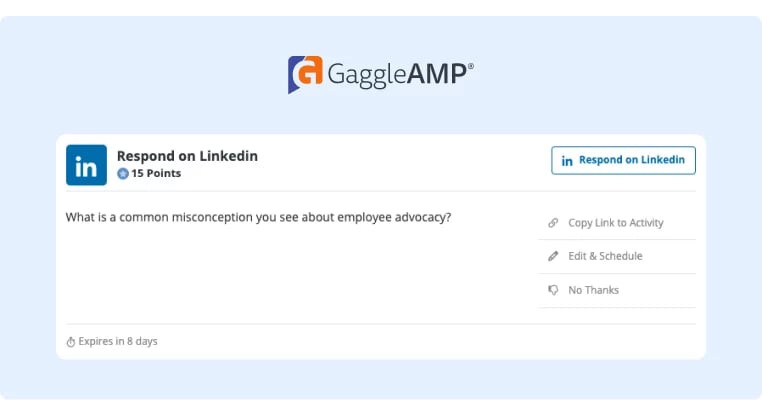
By giving executives these prompts, they don't have to stare at a blank page for hours, which will help them speed up the writing process.
Once they finish composing the post, execs can schedule it to go live directly inside the Gaggle dashboard. This way, they can create all of their content in one sitting, yet the content will go live consistently throughout the week.
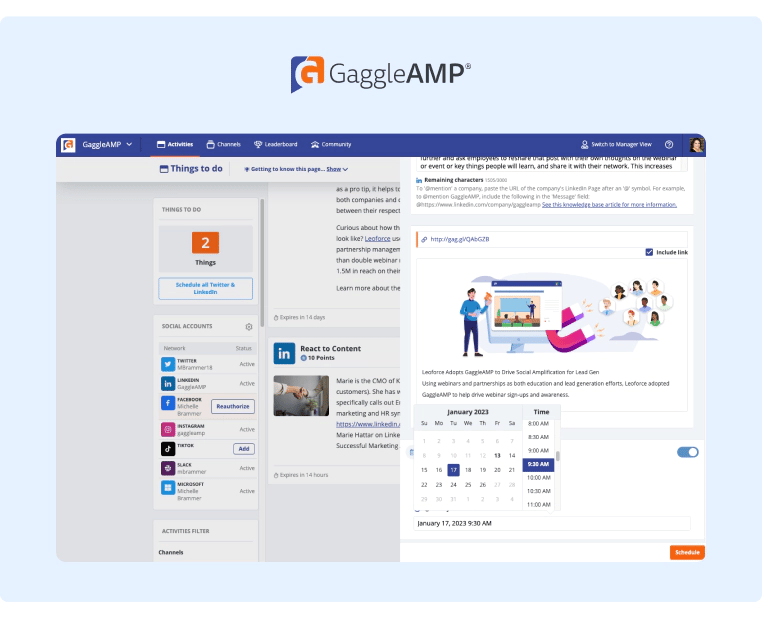
If you're still struggling to get executives to engage, you can set up a time to interview them, record the interview, and then hire a copywriter to turn the interview into social media posts.
Alternatively, you could extract clips from the interview and post them to social media. (This is also a great way to scale publishing frequency, as you'll be able to transform a single interview into many social media posts.)
Once you've created the content, you can go into GaggleAMP, prepare the social media posts for the executive, and then send them a notification to approve it for publishing.
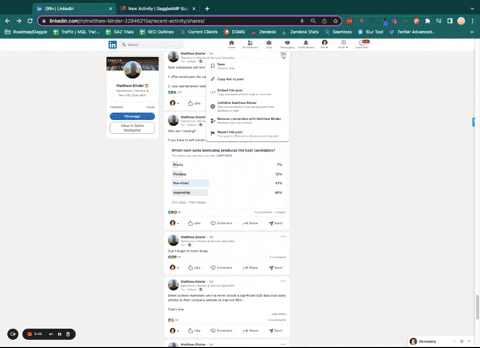
3. Leverage an Omnichannel Approach
Once you've created a handful of content pieces, the best way to maximize brand awareness is to remix that content and post it across various social media channels.
Even if you pick a specific channel as your main focus, you can still hire a creative team to repurpose that content (either in the same format or slightly adjusted) across other social media platforms.
Eric Siu is an excellent example of an executive who consistently posts the same content across all his social media platforms. As you can see, he created this tweet about conversations, and while it produced a handful of likes on Twitter, the same tweet with a lead-in on LinkedIn received nearly five times more engagement.
Call me boring but I'd rather have long conversations in intimate environments vs. short conversations at loud parties.
— ericosiu (@ericosiu) December 2, 2022
Quality > Quantity
Republishing content to different platforms is a task you can assign to an intern or even use a tool like Repurpose House to do for you.
4. Get Employees to Engage
Even if your executives have impressive experience, those starting with zero followers will probably need some help to gain initial traction. When executives publish their first post and see it receive lackluster engagement, it can be discouraging, and they may want to give up altogether.
To avoid this situation and ensure every post receives more initial traction, ask other employees to engage with executive content.
This initial engagement sends a positive signal to social media algorithms that the content is high-quality, which can help it receive more organic reach.
GaggleAMP can also help with this, as you can assign specific engagement activities to employees. For example, if the CMO publishes a new LinkedIn post, you can create an assignment for everyone on the marketing team to comment on that post.

5. Measure Results
The best way to prove the value of personal branding to your executive leadership team is to measure results. When executives see that their social media efforts are helping the company achieve other marketing strategy goals like increased brand awareness, website traffic, leads, sales, and more, they're more likely to continue engaging.
One easy way to measure social media metrics is using GaggleAMP's analytics dashboard.
You'll be able to see metrics like:
-
Estimated earned media value (EEMV)
-
Clicks
-
Reach
-
Social interactions
This gives you solid evidence to present to the leadership team, which can improve buy-in and even help you win additional budget for your social media strategy.
Examples of Executives on Social Media
If you want some inspiration as you're designing an executive social media strategy, here are a few company leaders that have built strong social media followings and leverage them to aid their company's initiatives.
Ross Hudgens – CEO of Siege Media
Ross Hudgens has created a strong following across LinkedIn and consistently produces very tactical SEO content. He runs a podcast and frequently repurposes clips from it on LinkedIn and also writes about learnings from SEO case studies that his company has executed.
He tends to publish content roughly three times per week.
Here’s a typical post from Ross:
Amanda Natividad – VP of Marketing at SparkToro
Amanda Natividad is known for her practical content marketing tips, along with a splash of humor and the occasional mom tips. This content style makes her a highly relatable and fun person to follow.
She's primarily active on LinkedIn and Twitter, and you can see that she often uses her influence to help promote content from SparkToro's founder Rand Fishkin.

John Bonini – Director of Marketing at Databox
John frequently posts helpful content marketing threads on LinkedIn and tends to take a very, very clear stance on various topics.
Most of his content is advisory, as he shares tactical best practices for marketers and discusses common mistakes. Here's a great example:
He has used his social media influence several times to aid with Databox initiatives, like hiring new marketers.
Nolan McCoy – Head of Content at Chili Piper
Nolan is a fun personality who has leveraged his content marketing skills to build a substantial social media following to aid Chili Piper's growth.
His content mainly focuses on key things he's learning at Chili Piper, though it also provides helpful content marketing tips and best practices.
He also uses his influence to promote Chili Piper initiatives and drive more traffic and brand awareness.
Here's a great example of how he uses his personal social media following to promote the company and other employees' growth:
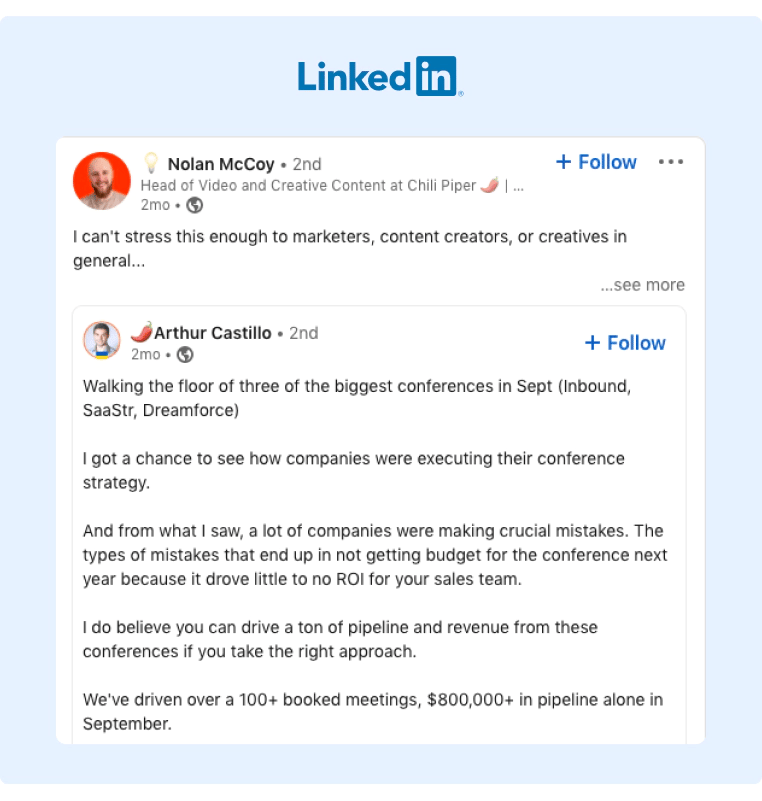
Creating an Effective Social Media Strategy For Executives
Social media is a powerful tool for c-suite executives to promote brand awareness and assist with other company initiatives.
However, few executives know how to create thought leadership content that meaningfully inspires their followers. To help your executives improve their social media presence, try using the steps outlined above.
To help them with the execution, consider implementing a tool like GaggleAMP that makes it possible to assign prompts or even pre-write social media posts for your executives to post.
You can learn more about how GaggleAMP can help your executive team build their online presence today by scheduling a demo or jumping into the platform for free today!






